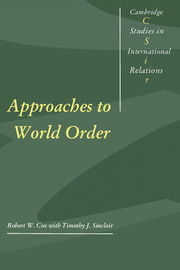Book contents
- Frontmatter
- Contents
- Preface
- Acknowledgements
- Part I Overviews
- Part II Theory
- Part III Interpretations
- 10 The global political economy and social choice (1991)
- 11 “Real socialism” in historical perspective (1991)
- 12 Structural issues of global governance: implications for Europe (1991)
- 13 Middlepowermanship, Japan, and future world order (1989)
- 14 Production and security (1993)
- 15 Global perestroika (1992)
- Part IV Multilateralism
- Complete bibliography of works by Robert W. Cox to 1995
- Index of names
- Index of subjects
- CAMBRIDGE STUDIES IN INTERNATIONAL RELATIONS
14 - Production and security (1993)
Published online by Cambridge University Press: 05 June 2012
- Frontmatter
- Contents
- Preface
- Acknowledgements
- Part I Overviews
- Part II Theory
- Part III Interpretations
- 10 The global political economy and social choice (1991)
- 11 “Real socialism” in historical perspective (1991)
- 12 Structural issues of global governance: implications for Europe (1991)
- 13 Middlepowermanship, Japan, and future world order (1989)
- 14 Production and security (1993)
- 15 Global perestroika (1992)
- Part IV Multilateralism
- Complete bibliography of works by Robert W. Cox to 1995
- Index of names
- Index of subjects
- CAMBRIDGE STUDIES IN INTERNATIONAL RELATIONS
Summary
Production and security, the linked themes of this essay, are not to be thought of as independent and dependent variables. Their relationship is reciprocal or dialectical. Furthermore, the relationship of these two terms should be understood as taking place within a third term: the changing structures of world order. This paper sketches a framework for thinking about these relationships in structural terms by placing the contemporary world in its historical dimension. It offers not an empirical study but some linked hypotheses that may be suggestive for more empirical investigation.
Fordism and post-Fordism
What is the relationship of “production” to military power and world order? Two critical thresholds in the contemporary history of production are separated by about one hundred years. During the last decades of the nineteenth century, a new system of production was initiated, which (with a certain anachronism in naming) is now called Fordism. Following a similar break in the dominant pattern of production, the era of post-Fordism is being initiated now, in the last decades of the twentieth century.
Fordism is a complex phenomenon. In purely technological terms it is based on mass production, the assembly line, and the replacement of the skilled worker under factory discipline by a large proportion of semi-skilled quickly trainable workers in Taylorized production systems. This new structure of production was linked to new structures of economic organization, consumption and income distribution, welfare, and the consolidation of the territorial basis of state power.
- Type
- Chapter
- Information
- Approaches to World Order , pp. 276 - 295Publisher: Cambridge University PressPrint publication year: 1996
- 3
- Cited by



